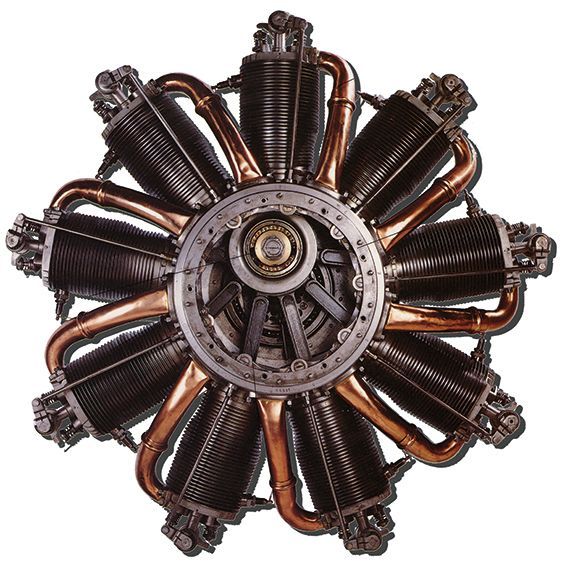
Rotary Engine
Although often credited to the American FD Farwell, the rotary engine has an earlier origin in a motor powered by compressed air developed by Australian pioneer Lawrence Hargrave some 8-9 years earlier.
On the other hand, it is certain that the French brothers Seguin gave the engine a commercial and mechanical life. 1909 saw the birth of this engine that would go down in history as the Gnôme Omega. This would later be followed by various, further developed designs that were more or less successful.
We are used to seeing someone turn on the propeller to start the engine of an older type of aircraft. However, this was not always necessary, with the help of a large crank a flywheel could be turned to start the engine. When one now compares starting a star or in-line engine in this way with starting a rotary engine, one understands that the latter will start much more easily. When starting a radial or inline engine one had to overcome inertia, (a body at rest wants to stay at rest) in a rotary engine the mass of the entire engine was used to start, which made the task much easier!
The decline and decay of the rotary engine had several reasons. One of the most important was the large rotating mass of the engine, which generated gyroscopic forces. However, these had very useful advantages, if the pilot could master them before these powers took away the desire to fly!
They gave the Sopwith Camel the advantage of turning very tight turns. On the other hand, there was the heavy load on the frame and engine mounting when the ignition was switched off!
There was no throttle control lever on Gnôme designs up to 100hp; the pilot had either 'full' power or 'nothing'. On top of the stick, the pilot had a switch that cut off the ignition, thus preventing the "spark plugs" from igniting the gas mixture. When the larger 160 hp came into existence, the need was felt to better control the power, certainly to make the aircraft more manageable during landing and taxiing. Now they started using 2 'magnetos', the first worked in the normal way: “on” or “off”. When the first magneto was switched off, a selector switch with 5 positions was available: “full power”, “half”, “quarter”, “one eighth” and “off”. In this way the normal firing sequence of the engine was interrupted.
A 4-stroke engine normally ignites every 2 revolutions; with the switch in the "half" position there was ignition every 4 turns, in the "quarter" position every 8 and in the "eighth" position only all 16 turns!
It is very interesting to hear this engine running. If you didn't know better, you would think the engine was badly tuned, that's how bad it is running!!
Another problem that plagued the engine designers was the demand for more power. This could only be achieved by making the engine larger: either in diameter or by adding a row of cylinders. In the first case the gyroscopic effects became completely unmanageable, the second solution had the same problem with the added problem that the rear row of cylinders was difficult to cool.
Another major reason against using a rotary engine in these modern times was its insatiable “hunger” for oil! The fuel is mixed with air in some kind of primitive carburetor – usually located at the rear of the crankshaft. This way the mixture enters the engine interior where it picks up all the loose, flying oil. When the mixture then enters the combustion chamber, it is rather a mixture of fuel, air and castor oil.
A rotary engine has no equal when it comes to the concept of "incomplete combustion". The castor oil, the less compressible of the two liquids, was spewed out into the free environment. It only took a short time before the entire fuselage behind the engine was covered with a layer of castor oil and of course the pilot in his open cockpit also got his share! A bonnet plating naturally contributed to the streamlining of the aircraft, but also served to keep the spreading of oil within limits. In practice, an opening was left in the plating at the bottom of the engine so that the oil had a way out.
On the other hand, the engine cowling was not exactly a favorite item with a rotary engine. The cylinders were air-cooled. As mentioned earlier, a double row of cylinders caused cooling problems. The plating kept the engine hotter than it should have been. The extra opening at the bottom of the bonnet also served to admit extra cooling air.
Many people notice the pleasant smell of burnt castor oil. Outside in the open air, on a green meadow, mixed with other scents, this can be a pleasant sensation. It still is if one wishes the pilot a good flight and continues with the tasks of a mechanic. But if you sit behind an engine that sprays you with burnt and unburnt castor oil, it becomes a completely different problem after a few hours of flying! After all, castor oil is also known for its bowel movement-promoting properties! So it would be almost impossible to expose oneself to this treatment without mentioning certain problems!!
To mitigate the cooling problem, the pilots turned the engines on and off. It was difficult to use a throttle as the engines needed a rotational movement to be cooled. That they were allowed to be shut down was due to the fact that: without ignition, no combustion and without combustion, no heat generation!
(Which could lead to a thrilling experience: restarting the engine! If the combustion chambers weren't overfilled with the explosive mixture, they certainly could: explode! However, if one or two cylinders were underfilled, the engine running poorly could be enough of a headache before the problem resolved itself.)
Although the hood could lead to overheating, it also increased power by swirling the incoming air around the cylinder heads. As a result, one got a better cooling than a "naked" engine that had to get its cooling from a frontal airflow.
These engines were easy to start in flight, by diving down, the turning propeller spinning the engine and it started itself!
They were also known for continuing to run despite the sometimes terrible damage done to one or two cylinders.
Many stories are known about the strong gyroscopic effects of this type of engines and the ability to turn their troubled pilots out of harm's way.
One of the most typical phrases to describe the turn aboard a Camel comes from Dik D-day: "Well, it can put your eyes on the same side of your nose!"






